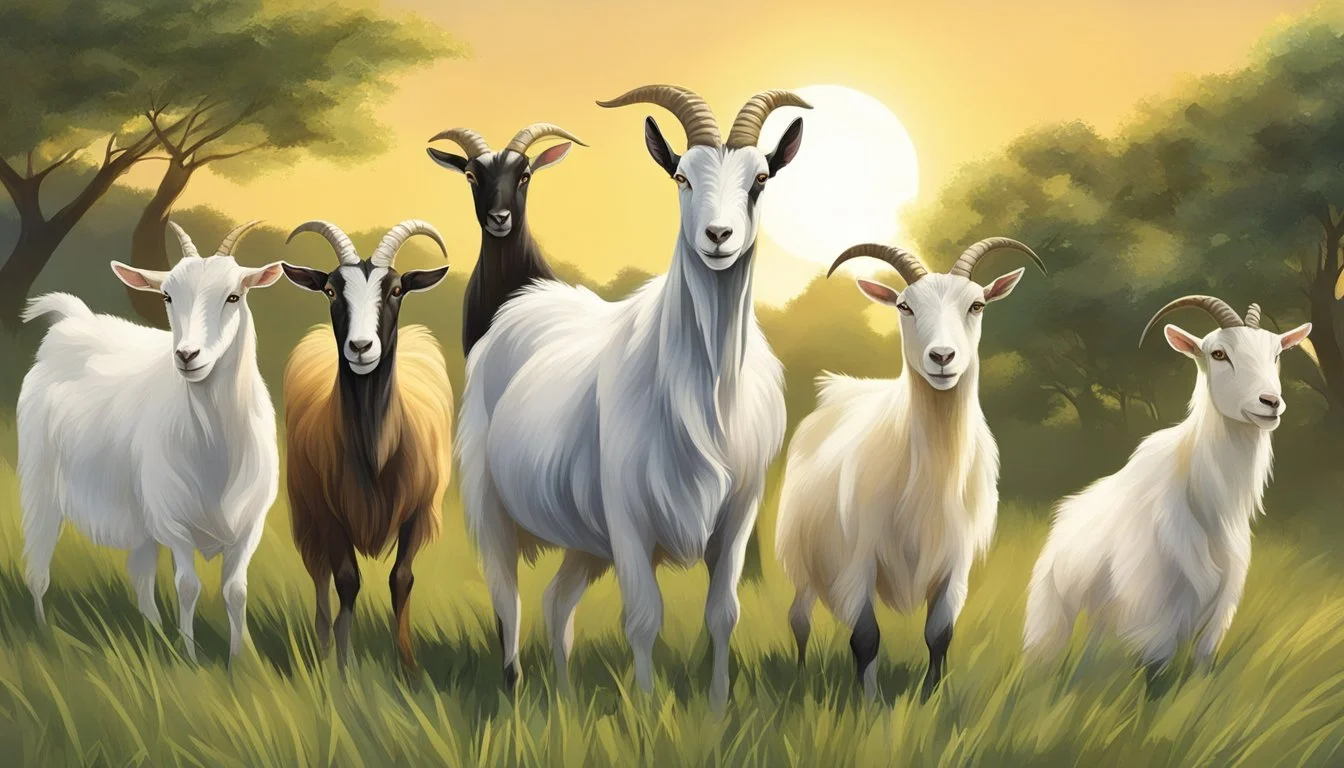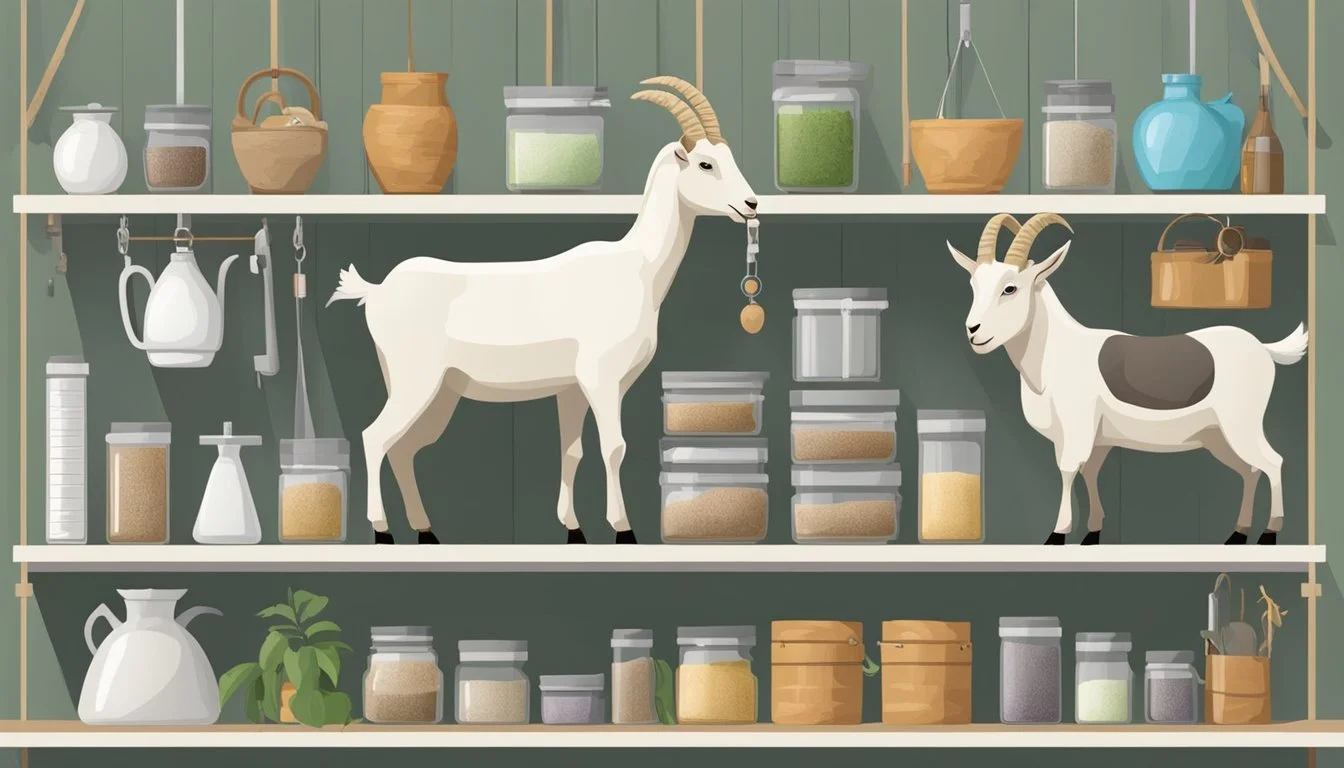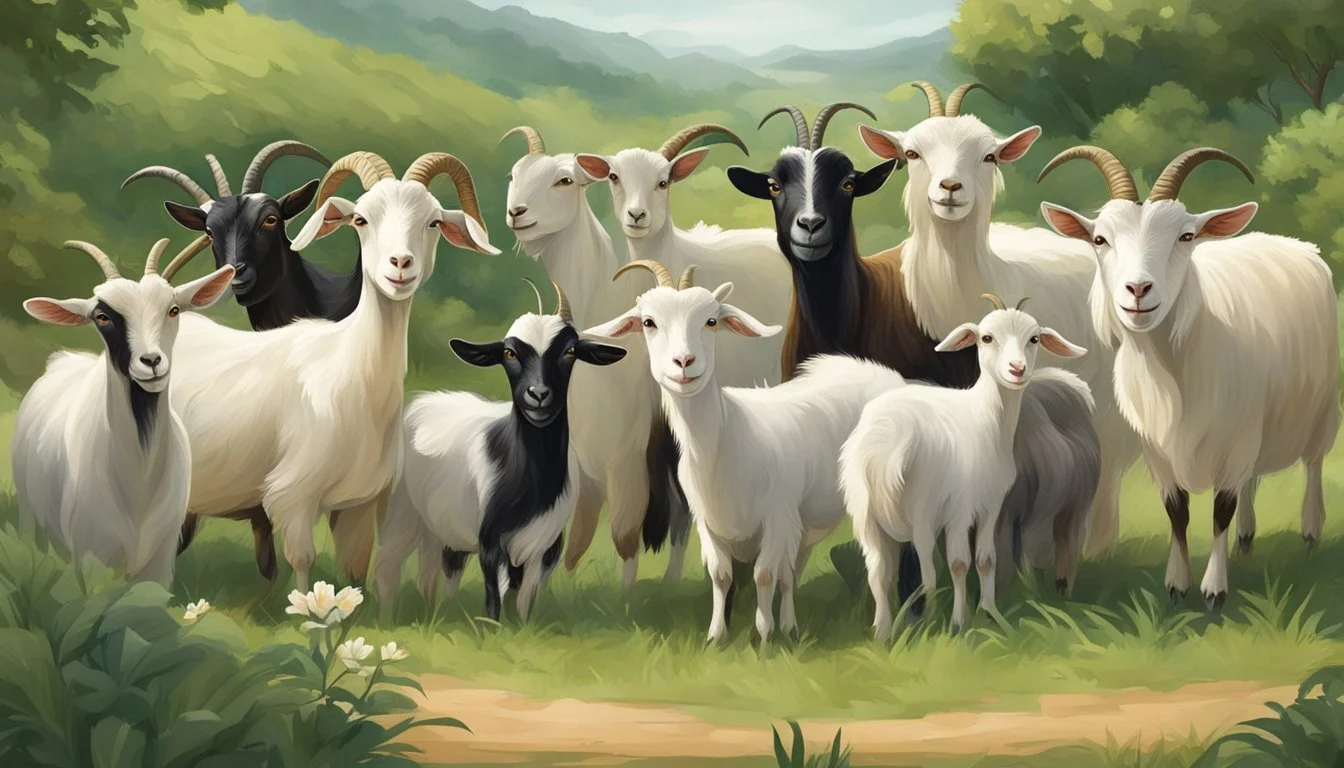How to Choose the Right Goat Breed for Your Family's Needs
A Comprehensive Guide
Selecting the right goat breed for your family's homestead is an important decision that can have a significant impact on your daily life and farming success. Goats are versatile animals that can provide a range of benefits, from milk and cheese production to land clearing and companionship. However, with so many breeds to choose from, it's essential to consider factors such as available space, the local climate, and the specific purposes you have in mind for your goats.
Understanding the unique characteristics and needs of different goat breeds is crucial in making an informed decision. Dairy breeds like Saanens are known for their high milk production, ideal for families looking for a steady supply of fresh dairy products. On the other hand, breeds like Pygmy goats are smaller and can be an excellent choice for those with limited space or for families looking primarily for pets. In addition, the Nigerian Dwarf goat offers both a petite size and high butterfat milk, making them a sought-after option for artisan cheese producers.
Before bringing goats into your life, it's important to assess not only the breed-specific traits but also factors like the animal's housing, fencing, and grazing space requirements. Each breed has its own temperament and maintenance needs, so it's advisable to align these with your family's lifestyle and agricultural goals. By taking the time to understand the various goat breeds and their suitability for your environment and needs, you will be well on your way to a rewarding experience with these engaging animals.
Understanding Goat Breeds
Choosing the right goat breed involves understanding the differences and spotting the most suitable traits for your family's needs. Different breeds excel in producing dairy, meat, or fiber, and they vary in size from small to large.
Distinguishing Between Dairy and Meat Breeds
Dairy goats are prized for their milk production. Breeds like the Alpine goat and Saanen are known for their substantial milk yield, with Alpines producing up to two gallons per day and Saanens a commendable 1.5 to 3 gallons. On the other hand, meat goats, such as Boer or Kiko, are raised primarily for their meat. They are typically larger in frame and build muscle easily, making them a substantial source of goat meat.
Recognizing the Value of Fiber Goats
Fiber goats are distinct for their quality production of mohair and cashmere. Breeds like the Angora and Cashmere goats are valued for their coats which provide luxurious fibers. These fibers are harvested through combing or shearing and are sought after for textile production.
Small vs. Large Goat Breeds
Size does matter when considering space, manageability, and purpose.
Small Goat Breeds:
Perfect for those with limited space.
Breeds such as the Nigerian Dwarf are manageable in size and have friendly dispositions, making them ideal for families.
Large Goat Breeds:
Require more room and resources.
Large breeds like Nubians have a high butterfat content in their milk, providing rich dairy.
Understanding each breed's characteristics will guide families in making informed decisions based on their agricultural ambitions, whether for dairy, meat, fiber, or as friendly farmyard companions.
Assessing Your Needs
Before adding goats to one's family, it is crucial to evaluate the specific goals, assess the availability of space and land, and consider the time and resources one is willing to invest. Each factor plays an integral role in selecting the most suitable goat breed for a homestead.
Identifying Your Goals
One should first articulate whether the primary objective is milk production, meat production, or perhaps showing goats at agricultural fairs. Dairy breeds, such as the Saanen, are celebrated for their high milk yield, often producing 1.5 to 3 gallons per day. For meat production, breeds like the Boer goat are preferable due to their rapid growth and muscular build.
Space and Land Requirements
The amount of space and quality of land available can greatly influence the choice of goat breed. Goats require adequate space to graze, roam, and exercise, which is essential for their health and wellbeing. Smaller breeds like the Nigerian Dwarf or Pygmy goats can be more suitable for modest acreage, whereas larger breeds might necessitate more expansive pastures.
Time and Resource Investment
Finally, one must realistically assess how much time and resources they can dedicate. All goats demand basic care, including feeding, sheltering, and veterinary attention, but some breeds might require more intensive management. For example, certain dairy goats might need milking twice a day, which adds to the daily time commitment one should be prepared for.
Making the right decision involves careful consideration of how well one's available resources align with the needs of the chosen breed.
Focusing on Health and Care
Selecting the right goat breed for your family involves understanding their specific health and care requirements. Substantial attention to diet, preventative healthcare, and adequate housing is essential for maintaining a healthy herd.
Nutritional Needs
Goats require a balanced diet rich in nutrients. A primary component of their feed is hay, which should be clean, mold-free, and compose the bulk of their daily intake. High-quality hay provides necessary fibers that aid in digestion. They also need a consistent supply of fresh water, which is vital for their metabolism and overall health. The addition of grain-based feed can supplement nutritional gaps, especially for does in lactation or kids that are growing.
Health Management
Effective health management is key to preventing diseases and parasitic infections. Regular deworming helps control internal parasites, which can be detrimental to a goat's health. Producers must ensure vaccinations are up-to-date to prevent common contagious diseases. It is also important to regularly inspect hooves for signs of hoof rot and to trim them as needed to maintain proper hoof health.
Shelter and Comfort
Appropriate shelter is crucial for protecting goats from harsh weather conditions and predators. Their living environment should be dry, well-ventilated, and free from drafts. Bedding should be clean and dry to prevent the growth of pathogens. In colder climates, additional measures may be necessary to maintain a warm enclosure. Providing adequate space allows goats to move freely and exhibit natural behaviors, which contributes to their overall well-being.
Selecting the Right Breed
When choosing a goat breed for your family, it is crucial to consider the primary purpose your goats will serve, whether it be dairy production, meat supply, or as pets and fiber providers.
Dairy Goat Breeds
For families prioritizing milk production, choosing a dairy goat breed is essential. Breeds like the Alpine goat can produce up to two gallons of milk daily, which is more than sufficient for household use. Furthermore, the Nubian goat, while producing less milk, possesses a higher butterfat content which is ideal for cheese making. On the other hand, Nigerian Dwarf goats produce a sweet milk with a higher butterfat content, making it perfect for rich dairy products while being suitable for smaller homesteads due to their compact size.
Meat Goat Breeds
If meat production is the goal, selecting a breed that grows quickly and produces high-quality meat is important. Breeds like the Boer goat are revered for their fast growth rate and excellent carcass qualities. They are hardy and adaptable to various environments, making them a popular choice for meat producers.
Popular Pet and Fiber Goats
For those interested in goats as pets or for their fiber, there are breeds that are friendly and suitable for these purposes. The Pygmy goat, for instance, is small, good-natured, and can be kept even in limited spaces, making them an excellent pet choice. Additionally, breeds such as the Angora or Cashmere goats are valued for their luxurious fiber used in textile production. These breeds require more grooming due to their coats but are often sought after by hobbyists and fiber artists.
Optimizing Milk Production
Choosing the right dairy goats is crucial for a family looking to maximize milk production for uses such as drinking, cheese making, or selling. Specific breeds excel in milk yield and butterfat content, but achieving optimal production also involves proper milking routines, selective breeding, and efficient processing of goat milk.
Milking Routines
Consistent and gentle milking routines are vital for maintaining the health of the dairy goat and ensuring steady milk production. Dairy goats should be milked at least twice daily at regular intervals to stimulate milk production and prevent udder complications. Cleanliness during milking cannot be overstated; sanitized equipment and proper handling safeguard the milk’s purity and prevent contamination.
Breeding for Milk Yield
Selective breeding for milk yield is a strategic approach to enhance milk production. High-yield dairy breeds like the Saanen, Alpine, and Nubian are known for their substantial milk output, often exceeding a gallon of milk per day. The Nigerian Dwarf, although smaller, boasts a high butterfat content, which is desirable for producing rich, creamy goat milk and cheese. Breeding should focus on these traits to fulfill the family’s milk production goals.
Processing Goat Milk
Once collected, processing goat milk efficiently can extend its shelf-life and increase its versatility. Goat milk must be cooled promptly to about 39°F (4°C) to maintain quality. It can be processed into various dairy products, such as cheese, which is enhanced by the butterfat content of breeds like Nigerian Dwarfs. Utilizing a pasteurizer can also be considered, which eliminates bacteria while preserving the milk’s nutritional value.
Effective Goat Raising Practices
When raising goats, it's paramount to implement a trio of practices: targeted feeding strategies, diligent pasture management, and informed breeding and genetics decisions. These areas are essential in maintaining a healthy and productive herd that meets the specific needs of one's family.
Feeding Strategies
Goats require a nutritionally balanced diet rich in certain key components to thrive. A primary part of their diet is hay, which should be of high quality to ensure proper digestion and health. Offering a variety of feed, including pasture and supplements, can fulfill their dietary needs and prevent deficiencies. It is crucial to provide:
High-quality hay: Forage should be the main component of their diet.
Supplements: Depending on the breed and purpose of the goats (milk, meat, or fiber), additional supplements may be necessary to meet their nutritional needs.
Pasture Management
The well-being of goats is significantly influenced by the quality of their pasture. Good pasture management includes:
Rotational grazing: This helps preserve the integrity of the land and ensures a consistent supply of fresh forage.
Secure fencing: Proper fencing is needed to protect goats from predators and prevent escape.
Breeding and Genetics
Understanding the genetics of goat breeds is key to achieving specific goals, whether it's producing milk, meat, or fiber. Breeders should focus on:
Selective breeding: Choose goats with desirable traits to improve the herd over time.
Record-keeping: Maintain detailed records of lineage and traits to make informed breeding decisions.
Equipment and Supplies for Goat Care
Selecting the right equipment and supplies is crucial for the successful care and management of goats. This includes everything from basic goat care supplies to specialized milking and breeding equipment.
Basic Goat Care Supplies
Goats require daily essentials like fresh water and proper feeding equipment. Water troughs or automatic waterers ensure constant hydration, while feeders should be designed to minimize waste. For nutrition, a well-balanced diet includes hay, grains, minerals, and vitamins. Collapsible feed bins and hay racks are beneficial in keeping their feed secure and clean from contamination.
Fencing and Housing Essentials
A secure fencing system is vital to protect goats from predators and prevent escape. Woven wire fencing, at least 48 inches tall, is recommended to keep goats contained and safe. Shelter is equally important to provide protection from the elements. A simple three-sided shed can serve as adequate shelter for goats to retreat from rain, snow, and sun. To optimize grazing areas, rotational grazing systems enhance pasture longevity and prevent overgrazing.
Milking and Breeding Equipment
For those raising goats for dairy, proper milking equipment such as stainless steel milk buckets, milk stands, and udder sanitation supplies are essential. Breeding goats will require additional supplies such as kidding pens, heat detection aids, and potentially artificial insemination kits for controlled breeding programs. Always ensure that each piece of equipment is kept clean to maintain the health and hygiene of your goats.
Common Challenges and Solutions
Choosing the right goat breed for your family involves considering several factors, from temperament to health maintenance. Here's how to tackle some common hurdles.
Behavioral Issues
Goat behavior varies considerably between breeds, with some being more docile and others more mischievous or aggressive. Goats like the Nigerian Dwarf are known for their friendly nature, suitable even for families with children. On the other hand, for breeds that can be more assertive, early socialization and consistent training are essential to foster a docile temperament and smooth integration into family life.
Environmental Challenges
Not all goats are equally hardy in different environmental conditions. For instance, some breeds thrive on rich pasture, while others, such as those adept at clearing weeds, are more efficient in rougher terrains. When selecting a goat, one must ensure that their habitat can provide appropriate forage or grass necessary for the breed's well-being. This alignment of breed to environment reduces stress and promotes good health.
Maintaining Good Health
A cornerstone of goat care is maintaining good health through proper nutrition and parasite control. A balanced diet that meets nutritional requirements helps prevent disease and maintains vigor. It is also crucial to execute a regular deworming schedule as goats are susceptible to parasites. Choose a breed with a known resilience to local diseases, and establish a relationship with a veterinarian to assist with care and maintenance, ensuring long-term health and productivity.
Sustainability and Self-Sufficiency
When choosing the right goat breed for your family, addressing sustainability and self-sufficiency is essential. Selecting a breed that thrives on natural forage and seamlessly integrates into your homesteading efforts can significantly enhance long-term viability and reduce feed costs.
Natural Grazing and Feed Conservation
Opting for goat breeds that are well-adapted to natural grazing can lead to substantial feed conservation. Breeds like the Kiko are renowned for their ability to thrive on diverse forages, ranging from grasses to broadleaf weeds, minimizing the reliance on supplemental feed. High-forage diets not only reduce costs but also promote a more self-sufficient homestead. Practices such as pasture rotation are beneficial, as they allow for the sustainable use of land while naturally controlling parasites, an important consideration for maintaining a healthy goat herd.
Integrating Goats into a Sustainable Homestead
In a sustainable homestead, goats play a multifaceted role. They are effective at weed control, reducing the need for chemical herbicides while also contributing to soil fertility through their manure. Goats can consume and help break down organic waste, turning potential waste into valuable compost for garden use. By choosing the right breed, such as dairy breeds like Nubian or LaMancha for milk, or Angora or Cashmere for fiber, families can tailor their goat herds to meet specific homesteading goals, leading to a more resilient and self-sufficient lifestyle.
Community and Support
When embarking on the journey of goat ownership, homesteaders can greatly benefit from the collective wisdom of the goat farming community. The support of experienced breeders and the structured learning from organizations dedicated to goat care are invaluable resources, especially for beginners.
Joining Goat-Related Organizations
Joining goat-related organizations is a critical step for homesteaders. These groups provide access to a wealth of information including breed-specific advice, care techniques, and best practices. For instance, the American Goat Federation offers resources and support for goat farmers of all experience levels, fostering a community that promotes the sharing of knowledge and experiences.
Learning from Experienced Goat Farmers
By learning from experienced goat farmers, beginners gain practical, hands-on knowledge that goes beyond what can be found in books or online. Seasoned farmers can offer guidance on the nuances of caring for different breeds. Homesteaders should seek out local farming groups or online forums such as Goat Spot for mentorship opportunities and to connect with others who can help troubleshoot the unique challenges of goat farming.







